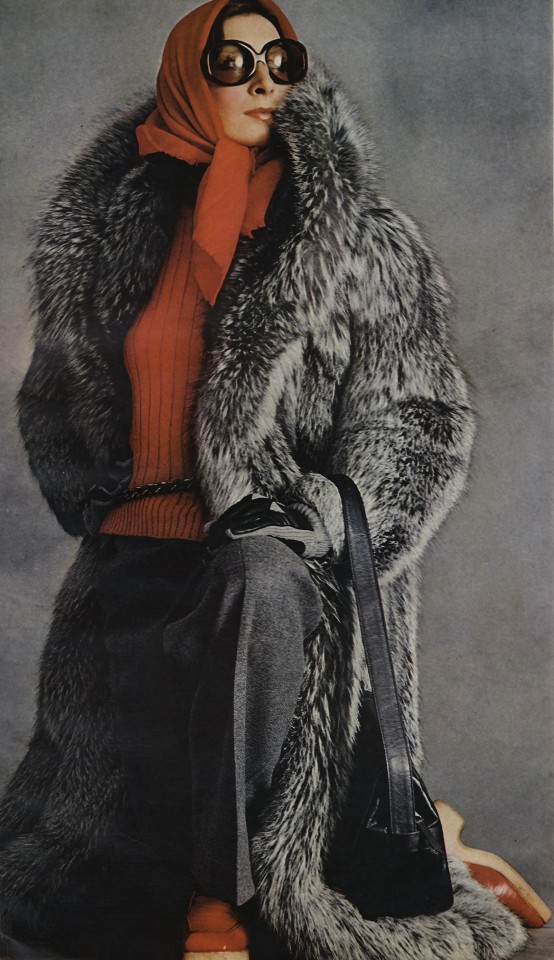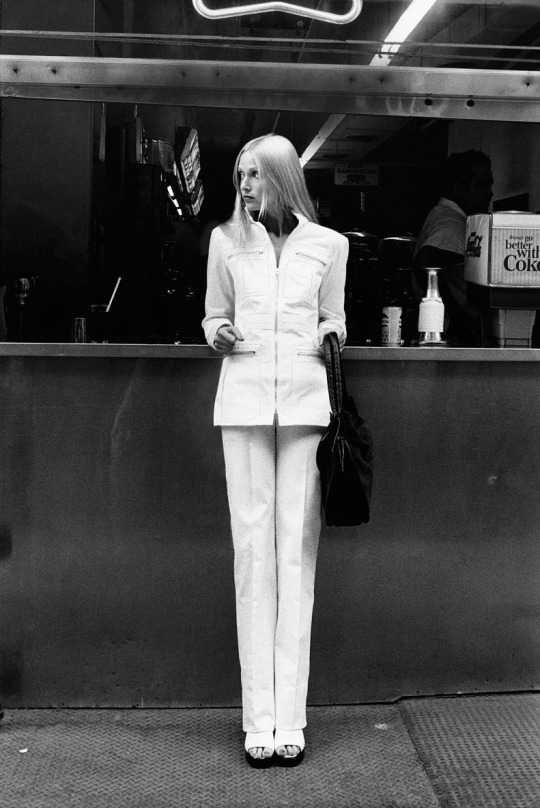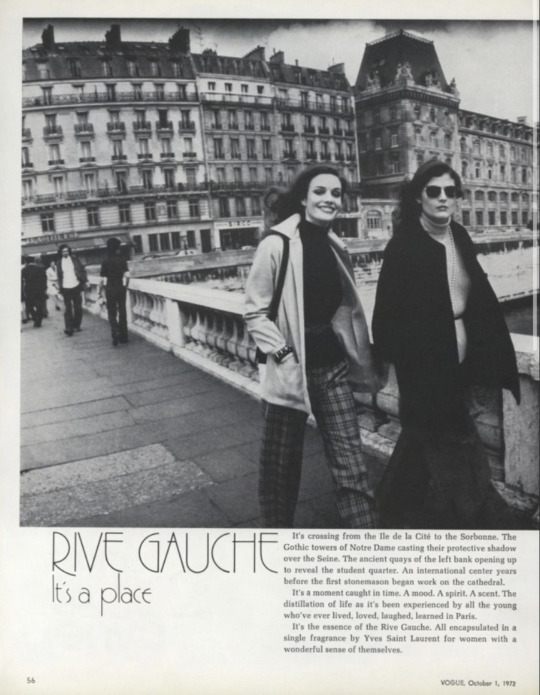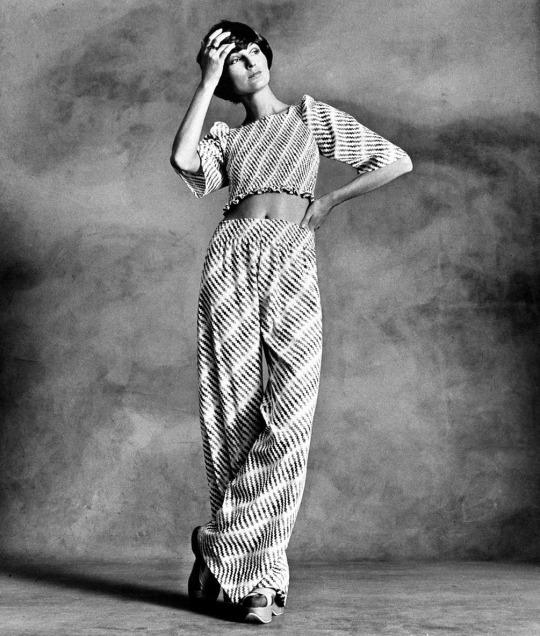#vogue us 1972
Photo

Lady Gaga, transforms into Marisa Berenson in a Paul Poiret dress’ recreation of Marchesa Luisa Casati Stampa for vogue US “Remembrance of things Proust” in January 1972. Photo by Steven Meisel for Vogue UK, December 2021.
#2021#lady gaga#Steven Meisel#marchesa luisa casati#marchesa luisa casati stampa#remembrance of things proust#proust#marisa berenson#paul poiret#luisa casati#paul poiret dress#Vogue UK#vogue uk 2021#vogue us#vogue us 1972#1972#marquise#marquise casati#La Marquise Casati#Marquise luisa casati#marchesa
53 notes
·
View notes
Text

US Vogue October 15, 1972
Anjelica Huston wears a natural silver fox coat. By Oscar de la Renta. Bright red sweater by Korrigan, gray flannel pants and belt by yves Saint Laurent Rive gauche, knit and leather gloves, by Keyser, red muffler, by Echo, sunglasses, Riviera, thick-soled crepe shoes, by Shoe Biz. Hairdressing, Cinandre.
Anjelica Huston porte un manteau en renard argenté naturel. Par Oscar de la Renta. Pull rouge vif par Korrigan, pantalon en flanelle gris et ceinture par yves Saint Laurent Rive gauche, gants en tricot et cuir, par Keyser, cache-nez rouge, par Echo, lunettes de soleil, Riviera, Chaussures à semelles épaisses en crêpe, par Shoe Biz. Coiffure, Cinandré.
Photo Irving Penn
vogue archive
#us vogue#fashion 70s#1972-73#fall/winter#automne/hiver#ready to wear#prêt à porter#oscar de la renta#yves saint laurent rive gauche#korrigan#echo#riviera#keyser#shoe biz#anjelica huston#irving penn#silver fox#renard argenté
32 notes
·
View notes
Text




Lady Gaga's look is inspired by these photos taken by Cecil Beaton of Marisa Berenson dressed as Marchesa Louisa Casati for Vogue US' "Remembrance of Things Proust" in January 1972.
#lady gaga#stefani germanotta#haute couture#fashion#fashion editorial#marchesa casati#vogue us#vogue magazine#marchesa louisa casati#marcel proust#remembrance of things proust#january 1972#cecil beaton#marchesa luisa casati stampa#black and white photography#sepia photography#december 2021#british vogue#vogue italia
169 notes
·
View notes
Photo

Edie Baskin wearing Yves Saint Laurent, photographed by Berry Berenson for Vogue US, January 1972.
#edie baskin#yves saint laurent#ysl#berry berenson#vogue us#american vogue#vogue#1972#fashion photography#photo shoot#fashion#photography#1970s
345 notes
·
View notes
Text

Margrit Ramme by Helmut Newton
- US Vogue, March 1972
15 notes
·
View notes
Text

Susan Bottomly in US Vogue, October 1972.
#susan bottomly#vogue#US vogue#october#1972#1970s#susan bottomly 1970s#october 1972#fall 1972#black and white#advertisement#susan bottomly black and white
6 notes
·
View notes
Text

Vogue US Oct 1972 - Karen Graham by Richard Avedon
62 notes
·
View notes
Photo


“Great Day Looks in the New York Collections”
US Vogue September 1, 1972
© Kourken Pakchanian
#Susan Schoenberg#1970s#1970s fashion#New York City#vogue#Kourken Pakchanian#fashion photography#seagrams building#1972
165 notes
·
View notes
Text

Cher with black cat, photographed by Richard Avedon, US Vogue April 1, 1972
151 notes
·
View notes
Text
For decades, it’s been unthinkable that Alaska could let a Democrat occupy its only seat in the House of Representatives, which had been held by the late GOP Rep. Don Young since 1972. But in the background, as Americans in the lower 48 were captivated by races in Georgia or Arizona, that’s exactly what’s happened: Alaskans voted 55-45 in favor of Democrat Mary Peltola, a former state legislator who just won her first full term over celebrity ex-Gov. Sarah Palin.
Peltola had just enough time to drop off her suitcase in Washington after winning the seat in an August special election. Palin was also her main opponent then, and in the months since, Peltola only grew her lead. She was helped in part by ranked-choice voting in its Alaska general-election debut. The system, which transfers votes to second-choice candidates when a voter’s first pick is eliminated, has drawn national attention and sometimes controversy.
Elections are a long affair in the 49th state, where challenges like distance, isolation, and tough weather abound, and mail-in ballots that are postmarked by election day have up until ten days to arrive for counting. The Alaska Division of Elections doesn’t count absentee, mail-in, and questioned ballots—many of which come from rural, predominantly Alaska Native regions—until after election day.
It’s not a system that benefits election-denying extremists like Palin, and Palin is not a good loser. The ex-governor has been hinting since polls closed that she’ll challenge the results of the race. She was sowing doubt and misinformation about ranked-choice voting as early as August, as I reported at the time:
“It’s bizarre, it’s convoluted, it’s confusing and it results in voter suppression,” Palin told the CPAC crowd. “It results in a lack of voter enthusiasm because it’s so weird.” None of that is true. Maine has been doing ranked-choice voting since 2016, and several cities and municipalities around the country have also adopted the system. “There isn’t a higher rate of incomplete or spoiled ballots in ranked choice races compared to ballots in elections using plurality voting,” Amy Fried, a professor of political science at the University of Maine, told Mother Jones. “Nor is turnout lower.” Rick Pildes, a constitutional law professor at the New York University School of Law, noted, “There’s no evidence voters have been confused or don’t understand how to rank candidates one, two, three.”
Palin was the first to sign her name last week to a citizens initiative that would overturn ranked choice voting.
For her part, Peltola has been frank that ranked-choice voting helped her, as she told Teen Vogue earlier this month: “I was very pleasantly surprised by the outcome. The timing was just right. [This new voting system] will help us get out of closed partisan primaries, which result in very extreme and sometimes fringe candidates winning.”
With Peltola’s win, Alaskans have demonstrated that being geographically disconnected from the rest of the country doesn’t mean they’re less connected to preserving democracy and abortion rights. Palin, who had the endorsement of Donald Trump, is an election conspiracist and proponent of misinformation. Peltola has openly supported codifying abortion rights into federal law—like her campaign slogan promises, she’ll be a “pro-choice, pro-fish” voice in Congress.
#us politics#news#mother jones#op eds#2022#sarah palin#rep. Mary Peltola#Alaska#rep. don young#us house of representatives#2022 elections#2022 midterms#ranked-choice voting#Alaska Division of Elections#teen vouge
54 notes
·
View notes
Photo

US Vogue November 15, 1972 : Raquel Welch by Richard Avedon
22 notes
·
View notes
Text


US Vogue November 1, 1972
Estée Lauder Perfume/Parfum
Karen Graham wears a Sweater and pants by Stan Herman.Karen Graham porte un Pull et un pantalon par Stan Herman.
Photo Victor Skrebneski
vogue archive
#us vogue#beauty 70s#november 1972#fashion 70s#estée lauder#perfume#parfum#karen graham#stan herman#victor skrebneski#advertising#publicité#beauty
30 notes
·
View notes
Note
do you have any book recs?
*sorry it took me so long to respond, i wanted to do it right*
a few from the pile of books im currently working through:
Fight Like Hell - Kim Kelly -
A revelatory and inclusive history of the American labor movement, from independent journalist and Teen Vogue labor columnist Kim Kelly. Freed Black women organizing for protection in the Reconstruction-era South. Jewish immigrant garment workers braving deadly conditions for a sliver of independence. Asian American fieldworkers rejecting government-sanctioned indentured servitude across the Pacific. Incarcerated workers advocating for basic human rights and fair wages. The queer Black labor leader who helped orchestrate America's civil rights movement. These are only some of the working-class heroes who propelled American labor's relentless push for fairness and equal protection under the law. The names and faces of countless silenced, misrepresented, or forgotten leaders have been erased by time as a privileged few decide which stories get cut from the final copy: those of women, people of color, LGBTQIA people, disabled people, sex workers, prisoners, and the poor. In this definitive and assiduously researched work of journalism, Teen Vogue columnists and independent labor reporter Kim Kelly excavates that untold history and shows how the rights the American worker has today — the forty-hour workweek, workplace-safety standards, restrictions on child labor, protection from harassment and discrimination on the job — were earned with literal blood, sweat, and tears. Fight Like Hell comes at a time of economic reckoning in America. From Amazon's warehouses to Starbucks cafes, Appalachian coal mines to the sex workers of Portland's Stripper Strike, interest in organized labor is at a fever pitch not seen since the early 1960s. Inspirational, intersectional, and full of crucial lessons from the past, Fight Like Hell shows what is possible when the working class demands the dignity it has always deserved.
Limits and Beyond: 50 years on from The Limits to Growth, what did we learn and what’s next? -
In 1972, a book changed the world. The Club of Rome commissioned a report that shifted how we see what humans are doing to the planet. Looking back five decades later, what happened next, what did we do and not do, what did we learn, and what happens now? In The Limits to Growth, a team from MIT studied the way humans were using the resources of the earth. Using sophisticated computer modelling, the researchers developed scenarios to map out possible paths for humanity, the global economy and the impact on the planet. Were their models right? What did the rest of the world do about it? Now, in 2022, the Club of Rome have brought two of the original authors from the 1972 book, Dennis Meadows and Jorgen Randers, along with an array of other world-renowned thinkers, scientists, analysts and economists from across the globe to answer these questions and grapple with the most acute issue of our time. In the first section, “Echoes of a Great Book”, Ugo Bardi sets the scene with an in-depth examination of the original report and the effect it has had on how we might think about what humanity is doing to the world. Jorgen Randers and Dennis Meadows then ask what the first book actually said and answer the most common questions that people ask about the book and progress since. Further explorations of the impact and consequences of the ground-breaking original book follow. Next, in the “Still the Economy, But What Kind?” section, the contributors examine the economic ideas that have informed and arisen from The Limits to Growth in the following decades and critique those assumptions and notions. They ask what must change if we are to stay within the limits set by nature. In the “New Lenses for a Different Future” section, thinkers from continents and cultures across the globe expand on their unique experiences of acting in and observing a world that may use all its resources before we wake up and act. The “Did We Learn? Will We?” section ponders where we go from here. Has humanity taken in the lessons of The Limits to Growth? What have we learned in the meantime? And, most importantly, what can we do about it now? Limits and Beyond: 50 years on from The Limits to Growth, what did we learn and what’s next? reaches back half a century to when the original report shook the world into realising that we live on a finite planet, brings it sharply up to date, and looks clear-eyed into the future. Limits and Beyond focuses the mind on the pressing issues of sustainability, global economics, and ecology that global politics and institutions need to grapple with to ensure the survival of the human race. Limits and Beyond is the book that will shape the conversation about our place on the earth for the next 50 years and beyond.
Can we save the planet and the human race?
Discipline & Punish The Birth of the Prison - Michel Foucault
In this brilliant work, the most influential philosopher since Sartre suggests that such vaunted reforms as the abolition of torture and the emergence of the modern penitentiary have merely shifted the focus of punishment from the prisoner's body to his soul.
Socialism: Utopian and Scientific - Frederick Engels
Socialism, Utopian and Scientific is a political science classic that needs no preface. It ranks with the Communist Manifesto as one of the indispensable books for anyone desiring to understand the modern socialist movement. It has been translated into every language where capitalism prevails, and its circulation is more rapid than ever before. The book explains the differences between utopian socialism and scientific socialism, which Marxism considers itself to embody. The book explains that whereas utopian socialism is idealist, reflects the personal opinions of the authors and claims that society can be adapted based on these opinions, scientific socialism derives itself from reality. It focuses on the materialist conception of history, which is based on an analysis over history, and concludes that communism naturally follows capitalism. Engels begins the book by chronicling the thought of utopian socialists, starting with Saint-Simon. He then proceeds to Fourier and Robert Owen. In Chapter Two, he summarizes dialectics, and then chronicles the thought from the ancient Greeks to Hegel. Chapter Three summarizes dialectics in relation to economic and social struggles, essentially echoing the words of Marx
The New Confessions of an Economic Hit Man - John Perkins
The previous edition of this now-classic book revealed the existence and subversive manipulations of "economic hit men.” John Perkins wrote that they “are highly paid professionals who cheat countries around the globe out of trillions of dollars. Their tools include fraudulent financial reports, rigged elections, payoffs, extortion, sex, and murder.” In Perkins's case the tool was debt—convincing strategically important countries to borrow huge amounts of money for enormous, “development “ projects that served the very rich while driving the country deeper into poverty and debt. And once indebted, these countries could be controlled. In this latest edition, Perkins provides revealing new details about how he and others did their work. But more importantly, in an explosive new section he describes how the EHM tools are being used around the world more widely than ever—even in the U. S. itself. The cancer has metastasized, yet most people still aren't aware of it. Fear and debt drive the EHM system. We are hammered with messages that terrify us into believing that we must pay any price, assume any debt, to stop the enemies who, we are told, lurk at our doorsteps. The EHM system—employing false economics, bribes, surveillance, deception, debt, coups, assassinations, unbridled military power—has become the dominant system of economics, government, and society today. It has created what Perkins calls a “Death Economy.” But Perkins offers hope: he concludes with dozens of specific, concrete suggestions for actions all of us can take to wrest control of our world away from the economic hit men, and help give birth to a Life Economy. *About the Author- John Perkins was formerly Chief Economist at a major international consulting firm where he advised the World Bank, United Nations, the IMF, U.S. Treasury Department, Fortune 500 corporations, and governments in Africa, Asia, Latin America, and the Middle East. Since then, his books on economics and geo-politics have sold more than 1 million copies, spent many months on the New York Times and other bestseller lists, and have been published in over 30 languages. He is a founder and board member of Dream Change and The Pachamama Alliance, nonprofits devoted to establishing a world our children will want to inherit.
Biocentrism - Robert Lanza, MD w/ Bob Berman
Robert Lanza is one of the most respected scientists in the world. US News and World Report cover story called him a "genius” and a "renegade thinker,” even likening him to Einstein. Lanza has teamed with Bob Berman, the most widely read astronomer in the world, to produce Biocentrism, a revolutionary new view of the universe. Every now and then a simple yet radical idea shakes the very foundations of knowledge. The startling discovery that the world was not flat challenged and ultimately changed the way people perceived themselves and their relationship with the world. For most humans of the 15th century, the notion of Earth as ball of rock was nonsense. The whole of Western, natural philosophy is undergoing a sea change again, increasingly being forced upon us by the experimental findings of quantum theory, and at the same time, towards doubt and uncertainty in the physical explanations of the universes genesis and structure. Biocentrism completes this shift in worldview, turning the planet upside down again with the revolutionary view that life creates the universe instead of the other way around. In this paradigm, life is not an accidental byproduct of the laws of physics. Biocentrism takes the reader on a seemingly improbable but ultimately inescapable journey through a foreign universe (our own) from the viewpoints of an acclaimed biologist and a leading astronomer. Switching perspective from physics to biology unlocks the cages in which Western science has unwittingly managed to confine itself. Biocentrism will shatter the readers ideas of lifetime and space, and even death. At the same time it will release us from the dull worldview of life being merely the activity of an admixture of carbon and a few other elements; it suggests the exhilarating possibility that life is fundamentally immortal. The 21st century is predicted to be the Century of Biology, a shift from the previous century dominated by physics. It seems fitting, then, to begin the century by turning the universe outside-in and unifying the foundations of science with a simple idea discovered by one of the leading life-scientists of our age. Biocentrism awakens in readers a new sense of possibility, and is full of so many shocking new perspectives that the reader will never see reality the same way again.
4 notes
·
View notes
Photo

Model wearing Issey Miyake, photographed by Irving Penn for Vogue US, May 1972.
#issey miyake#irving penn#vogue us#american vogue#vogue#1972#fashion photography#photo shoot#fashion#photography#1970s
23 notes
·
View notes
Text

Margrit Ramme by Helmut Newton
- US Vogue, March 1972
9 notes
·
View notes
